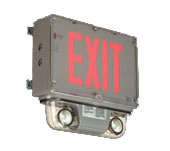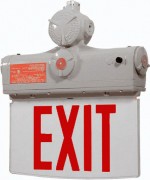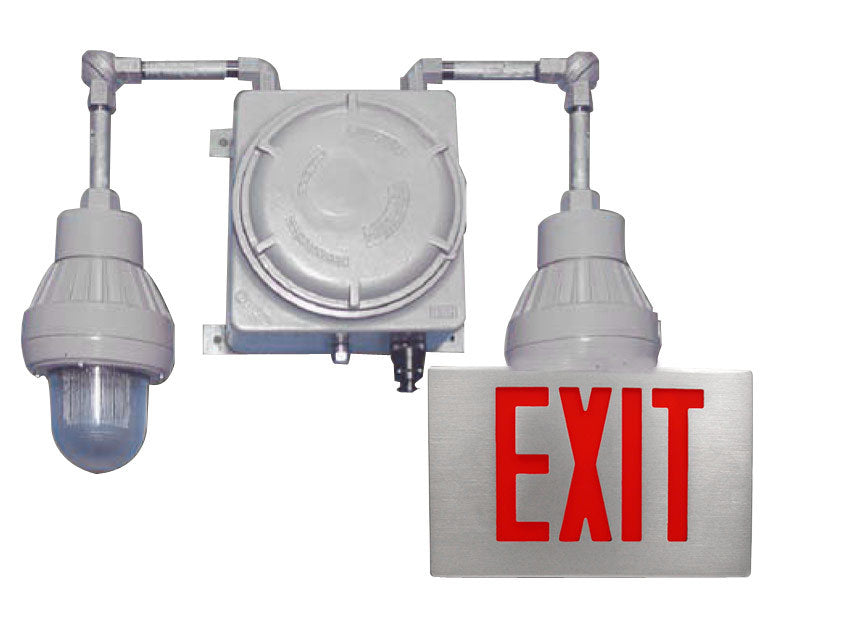Installing exit signs in hazardous environments requires more than standard fixtures. In areas where flammable gases, vapors, dusts, or fibers are present, using standard electrical equipment can increase the risk of fire or explosion. That’s why hazardous location exit signs are built with specialized sealed housings to prevent sparks from igniting dangerous atmospheres.
These products are often referred to as explosion proof exit signs. However, understanding the classification system is critical when choosing between Class 1 Division 1 and Class 1 Division 2 rated equipment—each is designed for a specific risk level and installation environment.

Class 1 Div 2 Exit Sign Combos are designed for areas adjacent to high-risk zones.
Hazardous Classification System (NEC)
The National Electric Code (NEC) outlines three classes of hazardous materials and two divisions of exposure risk:
| Class I (Gases & Vapors) |
Group A – Acetylene Group B – Hydrogen Group C – Ethylene Group D – Propane |
| Class II (Dusts) |
Group E – Metal Dust Group F – Coal Dust Group G – Grain Dust |
| Class III (Fibers) | No Subgroups |

Class 1 Division 1 Edge-Lit Exit Signs are fully sealed and UL listed for explosive environments.
Where Class 1 Division 1 Exit Signs Are Required
Class 1 Division 1 exit signs are used in environments where flammable gases or vapors are present under normal operating conditions. These signs must be fully sealed to prevent the ignition of gases that could seep inside the fixture.
Examples of Div 1 Environments:
- Paint spray booths
- Dry-cleaning facilities
- Fueling stations and vehicle maintenance bays
- Petrochemical processing plants
- Gas utilities and natural gas plants
Class 1 Division 2 – Adjacent or Low-Risk Areas
Division 2 zones are adjacent to Division 1 areas. These are locations where flammable materials are present only occasionally—such as via leaks, maintenance, or material transport. Fixtures here do not need the same level of sealing as Div 1 signs, but they must still be rated to prevent ignition in the event of vapor intrusion.
Making It Simple: Div 1 vs. Div 2
Here's a simplified analogy:
- Division 1: The device must operate safely even if fully submerged in gasoline fumes continuously.
- Division 2: The device must remain safe long enough to shut it off in the event of a sudden gasoline vapor leak.
Div 1 exit signs must be airtight and spark-proof, while Div 2 signs focus on minimal intrusion protection for intermittent exposure.
Hazardous Location Exit Sign Applications
Choosing the right fixture ensures compliance with OSHA, NFPA, and NEC standards—and more importantly, protects your facility and employees from avoidable accidents. Whether you're outfitting a manufacturing plant, fuel depot, or chemical storage site, we offer UL-listed solutions built to withstand even the most volatile conditions.

